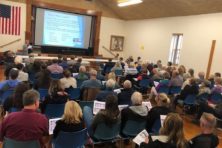Commentary: Attainable Housing Makes A Sustainable County
- Share
- Tweet
- Pin
- Share

by Jim Schuessler, Door County Economic Development Corporation
Writer and humorist Mark Twain popularized the phrase that he attributed to British Prime Minister Benjamin Disraeli: “There are three kinds of lies: lies, damned lies and statistics.”
If the British PM were alive today, perhaps he could somehow spin two things into a positive: the mess that is Brexit and – of critical importance to the mission of Door County Economic Development Corporation (DCEDC) – the decline in Door County’s population.
According to the U.S. Census Bureau, the county’s population has declined 2.9 percent during the past 15 years, and Sturgeon Bay’s has declined 5.5 percent during that same period. The median age of Door County is growing at four times the national average. Student enrollments have been declining. These are headwinds affecting sustainability.
What say ye, Mr. Disraeli?
The challenge here is not jobs. In fact, there are hundreds of jobs available in local companies, many offering great wages and benefits. The consistent year-over-year growth of J-1 visa workers points to the need for added workforce.
If we are to fill the available jobs, people need an affordable place to live. Therefore, Door County’s sustainability is intertwined with the development of attainably priced housing.
More headwinds: Local wages for adults aged 25 to 34 have not budged in more than a decade. Nationally, student-loan debt exceeds $1.5 trillion, according to the St. Louis Federal Reserve. Seven million car loans are more than 90 days in arrears, something not seen in the depth of the Great Recession. Young people who would consider moving to Door County may be arriving with accumulated debt.
New apartments are coming online – and they are needed and appreciated – but at rates of $800 to 1,200 per month, these prices may be out of reach for people who are starting out.
DCEDC, in collaboration with other individuals and groups, is working on addressing the need for attainable housing for people with median household incomes of $32,400 to $64,800, representing 60 percent to 120 percent of Door County’s Area Median Household Income.
To address this need, DCEDC’s Attainable Housing Subcommittee is evaluating municipal-owned land and existing infrastructure, focusing on municipalities that are actually interested in attainable-housing development.
The Development Subcommittee is also developing a list of resources, including the Wisconsin Housing Economic Development Authority and U.S. Department of Agriculture, as well as organizations that are already achieving success in attainable-housing development, such as NeighborWorks Green Bay. We also need appropriate zoning and property covenants to achieve housing that meets specific needs.
Meanwhile, DCEDC’s Attainable Housing Subcommittee is planning a series of presentations about the recently completed Housing Analysis. The presentations will take place in Northern Door on May 21, in central Door on May 29 and in Southern Door on May 30.
To achieve our attainable-housing goals, several criteria must be considered:
• Building structures within town centers or communities with existing infrastructure
• Choosing sites close to schools, public transportation and other resources for more walkable and bikable communities
• Designing units and outdoor spaces with passive-design strategies to reduce energy needs naturally
• Using LEED and Energy Star checklists to decrease energy consumption
• Selecting durable fixtures, equipment, hardware and finishes that are easy to repair
So why should anyone care?
Well, consider that attainable housing supports vibrant and sustainable local development. It provides the opportunity for people to live near their work. Shorter commutes make it easier to attract and retain workers and reduce traffic. Workforce housing supports jobs in key sectors that serve residents and visitors alike.
Moreover, sustainability is tied to stable housing that serves as a foundation for individual and family well-being. Children who move less often do better in school. Adults and children experience better physical and mental health. Families are more likely to achieve upward mobility and self-sufficiency.
Pragmatically, our ecosystem is not suitable for significant population growth. It is, however, suitable for well-focused development that helps to ensure equity and sustainability so that Door County can remain a singularly special place.
Statistics point to the need for policy to achieve sustainability. The collaborative work of stakeholders can ensure that we achieve a strong foundation for future generations to build upon.


